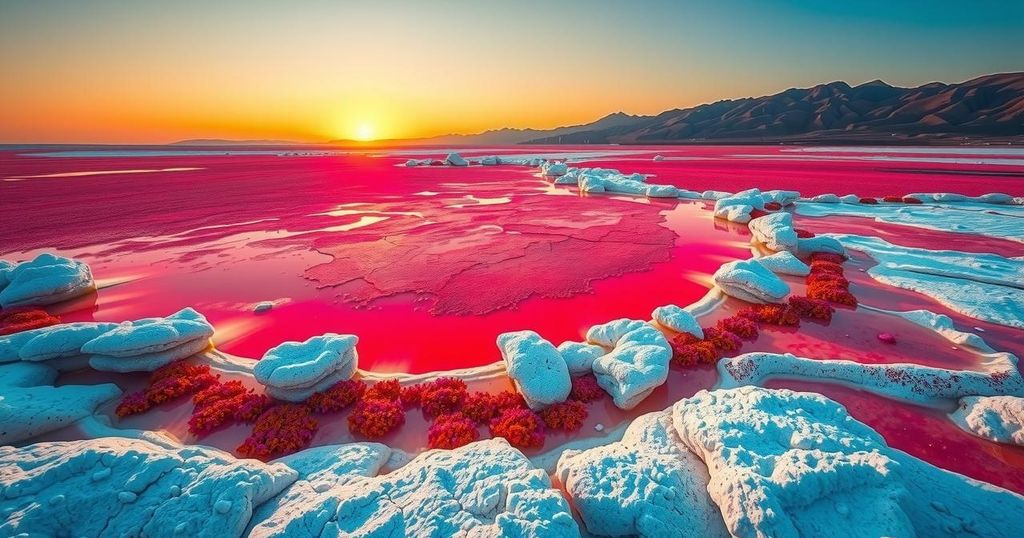The Strange Red Lake in Tanzania That Turns Animals to ‘Stone’

Lake Natron in Tanzania features stunning red waters due to microorganisms thriving in its highly alkaline conditions. However, its waters are caustic, preserving deceased wildlife as stone-like figures. Despite its harshness, the lake serves as a critical breeding ground for lesser flamingos who have adapted to survive here. Conservation efforts are in place to protect this delicate ecosystem while allowing for safe tourist exploration.
Nestled in the heart of Tanzania is a remarkable natural wonder known as Lake Natron. This striking lake, with its surreal crimson waters, simultaneously mesmerizes visitors with its beauty and terrifies with its deadly properties. Serving as one of Africa’s most unique natural phenomena, Lake Natron stands out for transforming deceased animals into what look like calcified statues, a rather eerie spectacle in nature’s own gallery.
Lake Natron extends across northern Tanzania as a shallow basin filled with alkaline water that gleams a blood-red hue under the intense African sun. Its unusual color can be attributed to specific microorganisms that thrive in these highly alkaline waters. Haloarchaea, along with cyanobacteria, produce vivid red pigments, a necessary adaptation for survival in such extreme conditions.
The chemistry of the lake creates a unique natural phenomenon—one not replicated anywhere else on Earth. With a pH level hitting around 10.5, which is dangerously close to household ammonia, the lake’s waters can burn the skin and eyes of most creatures. This toxic mix is the result of volcanic activities in the East African Rift System, as tectonic shifts split the continent over time. Additionally, minerals such as sodium carbonate and calcium carbonate seep into the lake from surrounding hills, heightening its caustic nature.
During drier periods, Lake Natron shrinks considerably, intensifying its chemical composition. The water temperature can reach a staggering 140°F (60°C), creating a boiling-like environment. Despite its width—measuring up to 9 miles (15 kilometers)—the lake is typically only 1.6 feet (0.5 meters) deep, meaning rapid evaporation takes place and it undergoes dramatic seasonal shifts.
Perhaps the most unsettling aspect of Lake Natron is its ability to preserve deceased wildlife, transforming them into lifeless yet stunning sculptures. When animals die near its shores, they begin to absorb the mineral-rich waters, which initiates a mummification-like process. Mineral deposits start replacing organic tissues, resulting in bodies that resemble stone, perfectly preserved yet devoid of their former vitality.
Award-winning photographer Nick Brandt highlighted this phenomenon in his extraordinary 2013 series, “Across the Ravaged Land,” featuring images of immortalized animals such as doves and fish eagles. They appear frozen in time, turned into haunting monuments by the lake’s unique properties. The petrification, remarkably quick, occurs when animals succumb to the lake’s high mineral concentration, absorbing it before evaporation sets in.
It’s noteworthy that, despite its harsh conditions, Lake Natron serves as a breeding sanctuary for lesser flamingos (Phoeniconaias minor). Approximately 1.5 to 2.5 million of these birds thrive here, relying on the unusual habitat for reproduction. Their specially adapted legs, equipped with tough scales, allow them to navigate the caustic waters without harm, showcasing nature’s ingenuity.
Interestingly, the same microorganisms providing the lake its vivid hue also serve as the main food source for these flamingos, contributing to their distinctive pink coloration. This natural cycle illustrates the intricate web of life that can exist, even in extreme environments like Lake Natron.
For travelers looking for something unconventional, Lake Natron offers an experience like no other. However, safe exploration of this natural wonder requires skilled local guides who understand the lake’s dangers and how to navigate them. The surrounding areas, with salt marshes and wetlands, are relatively safe and host an array of wildlife, including ostriches, pelicans, and greater flamingos.
Conservation is vital for preserving Lake Natron’s delicate ecology. The Tanzania Wildlife Management Authority has put strict tourism regulations in place to protect flamingo breeding habitats and maintain the lake’s unique chemistry, ensuring that future generations will be able to witness this extraordinary landscape.
In summary, Lake Natron is a stark reminder of the extremes that nature can present. Its vivid waters and petrified remains tell a dual story: one of beauty and one of the harsh realities of life. This incredible place is not just a testament to nature’s artistry but also highlights how life can adapt and thrive in even the most inhospitable environments. By understanding and protecting places like Lake Natron, we can appreciate the fragile yet resilient beauty of our planet.
In conclusion, Lake Natron stands out as a unique natural wonder that presents both beauty and danger. Its striking crimson waters, the survival adaptations of its inhabitants, and the macabre transformation of deceased animals into stone-like figures underscore the resilience of life even in extreme environments. The ongoing conservation efforts are crucial for maintaining this delicate ecosystem while allowing future generations to marvel at this astonishing phenomenon.
Original Source: thinkstewartville.com








